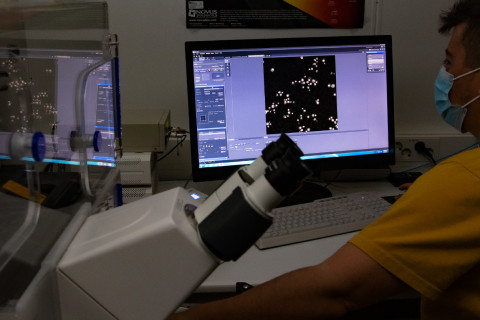Researchers from the University of Eastern Finland and the University of Montreal (Canada) have discovered that a micro-protein, which they named Nrs1, supports cell division and proliferation when nutrients are scarce. This result, published in PLOS Biology this month, sheds a new light on how evolution subtly reshapes the genomes of unicellular microorganisms, providing them with plasticity to adjust their growth and proliferation to ever-changing environments.
At the turn of the millennium, scientists became able to experimentally determine the DNA sequence of entire genomes. They next used this information to predict genome products: the proteins.
“At this time, very short DNA sections coding for very small proteins were overlooked. Why spend resources studying these tiny, shy dudes when there’s already so much to do with the big, tough guys? This strategy paid off to identify central, evolutionary conserved cellular mechanisms; but the adaptation potential, though, hides in less conserved, often short DNA sequences,” says University Researcher Sylvain Tollis who carried out the study in Montreal and at the Institute of Biomedicine, University of Eastern Finland.
Furthermore, micro-proteins are increasingly associated with disease in humans: for instance, humanin, which is only 24 amino acids long, is involved in neuronal cell death and survival(1), while the cancer-associated microprotein CASIMO1 promotes cell proliferation and motility in breast cancer cell lines through the actin cytoskeleton(2). These results urge the community to scrutinize smaller proteins, or micro-proteins, and other genome sequences previously left aside.
In the newly published study, the authors used the bakers’ yeast Saccharomyces cerevisiae to seek for molecular routes by which the information on nutrient availability could be communicated to the key molecules, called transcription factors, that orchestrate the commitment to division, referred to as the Start point. Indeed, cell growth and division are strongly affected by the availability of nutrients. For this purpose, they deleted from the yeast genome the main activators of cell division, and overexpressed one by one the remainder of yeast proteins, including many small ones. A unique micro-protein emerged from this screen as capable of rescuing cell proliferation despite the absence of key cell division activators. Further biochemical analyses and ground-breaking quantitative microscopy investigations revealed that cells express this protein only under poor nitrogen conditions, and when it is time to divide. The authors have therefore renamed it as Nrs1 for Nitrogen-Responsive Start regulator. Nrs1 binds to and activates the main transcription factors that trigger the decision to divide, providing an alternative, nutrient-regulated mechanism for Start activation.
Sequence analysis across yeast species indicated that Nrs1 is a recently-evolved microprotein, illustrating how microproteins can rapidly emerge to rewire fundamental cellular processes.
“Indeed, it seems reasonable to assume that short DNA sequences would require less evolution-selected mutations than long sequences to be functionally optimized. This work raises the hypothesis that micro-proteins would make a versatile tool for evolution to quickly rewire key cellular pathways and provide plasticity to adapt to changing environment,” Tollis concludes.
This study was funded by the Canadian Institutes of Health Research, Genome Quebec and Genome Canada, and the Sigrid Jusélius Foundation.
For further information, please contact:
University Researcher Sylvain Tollis, University of Eastern Finland, Institute of Biomedicine, sylvain.tollis (at) uef.fi, +35850 341 9874, https://uefconnect.uef.fi/henkilo/sylvain.tollis/
Research article:
Tollis S, Singh J, Palou R, Thattikota Y, Ghazal G, Coulombe-Huntington J, et al. (2022) The microprotein Nrs1 rewires the G1/S transcriptional machinery during nitrogen limitation in budding yeast. PLoS Biol 20(3): e3001548. https://doi.org/10.1371/journal.pbio.3001548
Keywords: cell division cycle, nutrient limitation, evolution, microprotein, gene transcription, quantitative microscopy
References:
1: Gong Z, Tasset I, Diaz A, Anguiano J, Tas E, Cui L, et al. Humanin is an endogenous activator of chaperone-mediated autophagy. J Cell Biol. 2018;217(2):635-47.
2: Polycarpou-Schwarz M, Gross M, Mestdagh P, Schott J, Grund SE, Hildenbrand C, et al. The cancer-associated microprotein CASIMO1 controls cell proliferation and interacts with squalene epoxidase modulating lipid droplet formation. Oncogene. 2018;37(34):4750-68.



